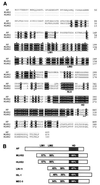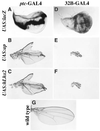Conservation of the expression and function of apterous orthologs in Drosophila and mammals
- PMID: 10051612
- PMCID: PMC26754
- DOI: 10.1073/pnas.96.5.2165
Conservation of the expression and function of apterous orthologs in Drosophila and mammals
Abstract
The Drosophila apterous (ap) gene encodes a protein of the LIM-homeodomain family. Many transcription factors of this class have been conserved during evolution; however, the functional significance of their structural conservation is generally not known. ap is best known for its fundamental role as a dorsal selector gene required for patterning and growth of the wing, but it also has other important functions required for neuronal fasciculation, fertility, and normal viability. We isolated mouse (mLhx2) and human (hLhx2) ap orthologs, and we used transgenic animals and rescue assays to investigate the conservation of the Ap protein during evolution. We found that the human protein LHX2 is able to regulate correctly ap target genes in the fly, causes the same phenotypes as Ap when ectopically produced, and most importantly rescues ap mutant phenotypes as efficiently as the fly protein. In addition, we found striking similarities in the expression patterns of the Drosophila and murine genes. Both mLhx2 and ap are expressed in the respective nerve cords, eyes, olfactory organs, brain, and limbs. These results demonstrate the conservation of Ap protein function across phyla and argue that aspects of its expression pattern have also been conserved from a common ancestor of insects and vertebrates.
Figures





References
-
- Banfi S, Borsani G, Rossi E, Bernard L, Guffanti A, Rubboli F, Marchitiello A, Giglio S, Coluccia E, Zollo M, et al. Nat Genet. 1996;13:167–174. - PubMed
-
- Kenyon C. Cell. 1994;78:175–180. - PubMed
-
- Krumlauf R. Cell. 1994;78:191–201. - PubMed
-
- Lawrence P A, Morata G. Cell. 1994;78:181–189. - PubMed
-
- De Robertis E M, Sasai Y. Nature (London) 1996;380:37–40. - PubMed
Publication types
MeSH terms
Substances
Associated data
- Actions
- Actions
Grants and funding
LinkOut - more resources
Full Text Sources
Molecular Biology Databases

